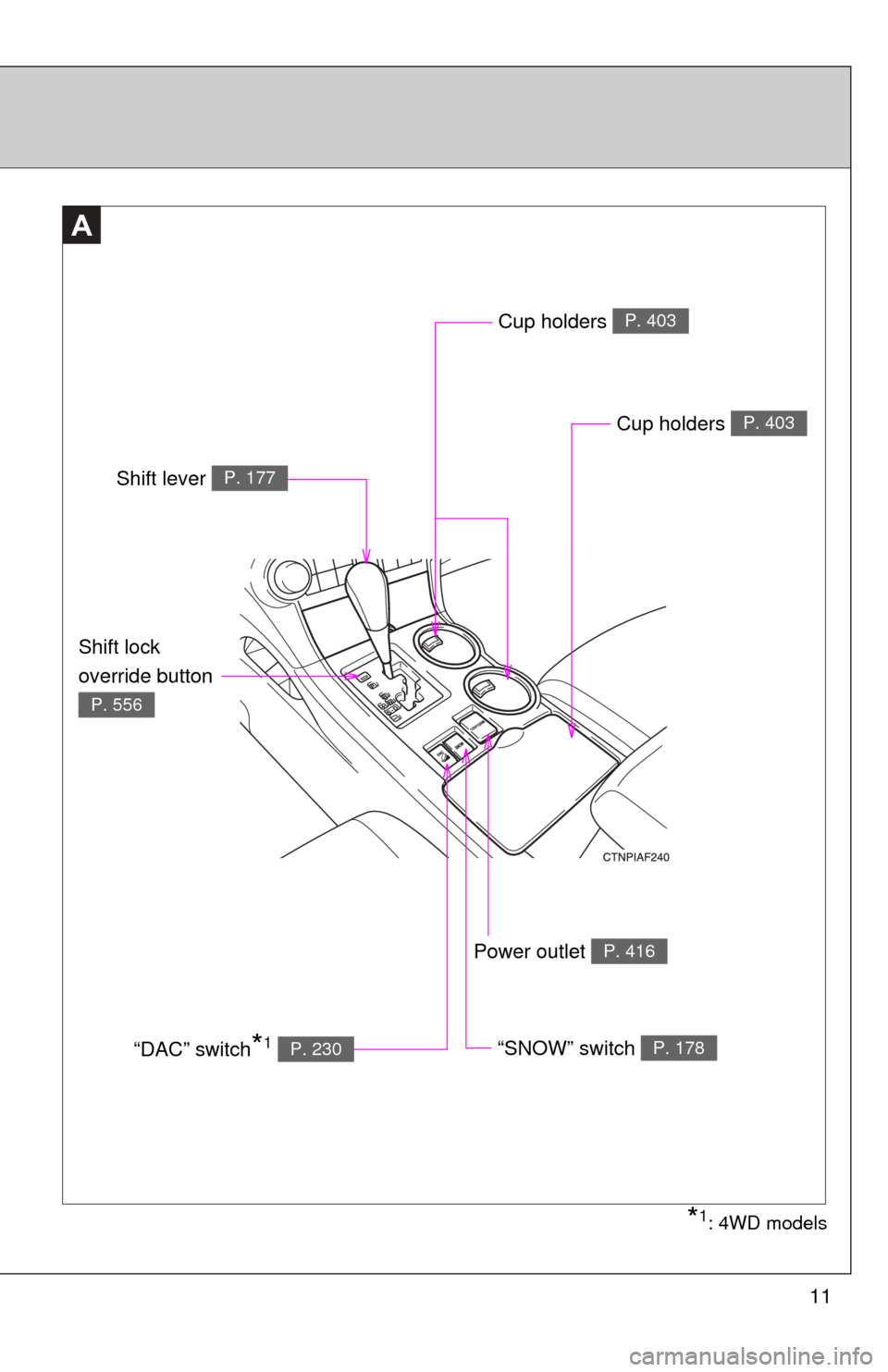2012 TOYOTA HIGHLANDER 4WD
[x] Cancel search: 4WDPage 3 of 636

1
2
3
4
5
6
7
3
2-3. Operating the lights and wipers
Headlight switch .................. 200
Fog light switch ................... 206
Windshield wipers and washer .............................. 208
Rear window wiper and washer .............................. 212
2-4. Using other driving systems
Cruise control ...................... 215
Rear view monitor system .............................. 219
Driving assist systems ........ 223
Hill-start assist control ......... 228
Downhill assist control system (4WD models) ...... 230
2-5. Driving information Off-road precautions ........... 233
Cargo and luggage ............. 238
Vehicle load limits ............... 242
Winter driving tips ............... 243
Trailer towing ...................... 247
Dinghy towing ..................... 265 3-1. Using the air conditioning
system and defogger
Front manual air conditioning system.......... 268
Front automatic air conditioning system.......... 275
Rear manual air conditioning system.......... 283
Rear automatic air conditioning system.......... 286
Rear window and outside rear view
mirror defoggers ............... 289
Windshield wiper de-icer .... 291
Using the steering wheel climate remote control
switches ........................... 292
3-2. Using the audio system Audio system ...................... 293
Using the radio ................... 297
Using the CD player ........... 304
Playing back MP3 and WMA discs ....................... 312
Operating an iPod .............. 320
Operating a USB memory ............................ 327
Optimal use of the audio system .............................. 335
Using the AUX port............. 339
Using the steering wheel audio switches.................. 341
Detachable pole antenna ............................ 344
3Interior features
Page 11 of 636

11
A
Power outlet P. 416
Cup holders P. 403
*1: 4WD models
Cup holders P. 403
Shift lever P. 177
“SNOW” switch P. 178“DAC” switch*1 P. 230
Shift lock
override button
P. 556
Page 159 of 636

When driving2
159
2-1. Driving proceduresDriving the vehicle............ 160
Engine (ignition) switch (vehicles with smart
key system).................... 170
Engine (ignition) switch (vehicles without smart
key system).................... 174
Automatic transmission...... 177
Turn signal lever .............. 182
Parking brake ................... 183
Horn ................................. 184
2-2. Instrument cluster Gauges and meters ......... 185
Indicators and warning lights .............................. 187
Multi-information display............................ 191 2-3.
Operating the lights and
wipers
Headlight sw itch ............... 200
Fog light switch ................ 206
Windshield wipers and washer ........................... 208
Rear window wiper and washer ........................... 212
2-4. Using other drivin g
s ystems
Cruise control ................... 215
Rear view monitor system ........................... 219
Driving assist systems ..... 223
Hill-start assist control ...... 228
Downhill assist control system (4WD models) ... 230
2-5. Driving information Off-road precautions ........ 233
Cargo and luggage .......... 238
Vehicle load limits ............ 242
Winter driving tips ............ 243
Trailer towing ................... 247
Dinghy towing .................. 265
Page 163 of 636

163
2-1. Driving procedures
2
When driving
CAUTION
●
Do not shift the shift lever to P while the vehicle is moving.
Doing so can damage the transmission and may result in a loss of vehicle\
control.
● Do not shift the shift lever to R while the vehicle is moving forward.
Doing so can damage the transmission and may result in a loss of vehicle\
control.
● Do not shift the shift lever to D while the vehicle is moving backward.
Doing so can damage the transmission and may result in a loss of vehicle\
control.
● Moving the shift lever to N while the vehicle is moving will disengage the
engine from the transmission. Engine braking is not available when N is
selected.
● During normal driving, do not turn off the engine. Turning the engine off
while driving will not cause loss of steering or braking control, but the
power assist to these systems will be lost. This will make it more difficult to
steer and brake, so you should pull over and stop the vehicle as soon as it
is safe to do so.
However, in the event of an emergency, such as if it becomes impossible
to stop the vehicle in the normal way: P. 569
● Use engine braking (downshift) to maintain a safe speed when driving
down a steep hill.
Using the brakes continuously may cause the brakes to overheat and lose
effectiveness. ( P. 178)
● When stopped on an inclined surface, use the brake pedal and parking
brake to prevent the vehicle from rolling backward or forward and causing
an accident.
● Do not adjust the position of the steering wheel, the seat, or the inside or
outside rear view mirrors while driving.
Doing so may result in a loss of vehicle control that can cause accidents
that may result in death or serious injury.
● Always check that all passengers' arms, heads or other parts of their bod-
ies are not outside the vehicle, as this may result in death or serious injury.
● Do not drive the vehicle off-road.
This is not a 4WD vehicle designed for real off-road driving. Proceed with
all due caution if it becomes unavoidable to drive off-road.
Page 164 of 636

164 2-1. Driving procedures
CAUTION
●4WD models: Do not drive across a river or through other bodies of water.
This may cause electric/electronic components to short circuit, damage
the engine or cause other serious damage to the vehicle.
● Do not drive in excess of the speed limit. Even if the legal speed limit per-
mits it, do not drive over 85 mph (140 km/h) unless your vehicle has high-
speed capability tires. Driving over 85 mph (140 km/h) may result in tire
failure, loss of control and possible injury. Be sure to consult a tire dealer
to determine whether the tires on your vehicle are high-speed capability
tires or not before driving at such speeds.
■ When driving on slippery road surfaces
●Sudden braking, acceleration and steering may cause tire slippage and
reduce your ability to control the vehicle, resulting in an accident.
● Sudden changes in engine speed, such as engine braking caused by up-
shifting or down-shifting, may cause the vehicle to skid, resulting in an
accident.
● After driving through a puddle, lightly depress the brake pedal to make
sure that the brakes are functioning properly. Wet brake pads may prevent
the brakes from functioning properly. If the brakes on only one side are wet
and not functioning properly, steering control may be affected, resulting in
an accident.
■ When shifting the shift lever
Be careful not to shift the shift lever with the accelerator pedal depressed.
This may lead to unexpected rapid acceleration of the vehicle that may
cause an accident and result in death or serious injury.
■ When the vehicle is stopped
●Do not race the engine.
If the vehicle is in any gear other than P or N, the vehicle may accelerate
suddenly and unexpectedly, and may cause an accident.
● Do not leave the vehicle with the engine running for a long time.
If such a situation cannot be avoided, park the vehicle in an open space
and check that exhaust fumes do not enter the vehicle interior.
Page 167 of 636

167
2-1. Driving procedures
2
When driving
CAUTION
■
When braking the vehicle
●When the brakes are wet, drive more cautiously.
Braking distance increases when the brakes are wet, and may cause one
side of the vehicle to brake differently than the other side. Also the parking
brake may not securely hold the vehicle.
● If the power brake assist function does not operate, do not follow other
vehicles closely and avoid downhills or sharp turns that require braking.
In this case, braking is still possible, but it will require more force on the
pedal than usual. Braking distance may also increase.
● Do not pump the brake pedal if the engine stalls.
Each push on the brake pedal uses up the reserve for the power-assisted
brakes.
● The brake system consists of 2 individual hydraulic systems: If one of the
systems fails, the other will still operate. In this case, the brake pedal
should be depressed more firmly than usual and braking distance
becomes longer.
Do not drive your vehicle with only a single brake system. Have your
brakes fixed immediately.
■ If the vehicle becomes stu ck or bogged (4WD models)
Do not spin the wheels recklessly when any of the tires is up in the air, or
stuck in sand or mud etc. This may damage the drive system components or
propel the vehicle forward (or in another direction) and cause an accident.
■ If you hear a squealing or scraping noise (brake pad wear limit indica-
tors)
Have the brake pads checked and replaced by your Toyota dealer as soon
as possible.
Rotor damage can result if the pads are not replaced when needed.
It is dangerous to drive the vehicle when the wear limits of the brake pads
and/or those of the brake discs are exceeded.
Page 169 of 636

169
2-1. Driving procedures
2
When driving
NOTICE
■
When encountering flooded roads
Do not drive on a road that has flooded after heavy rain etc. Doing so may
cause the following serious damage to the vehicle.
●Engine stalling
● Short in electrical components
● Engine damage caused by water immersion
In the event that you drive on a flooded road and the vehicle is flooded, be
sure to have your Toyota dealer check the following.
● Brake function
● Changes in quantity and quality of oil and fluid used for the engine, tran-
saxle, transfer (4WD models), differential (4WD models), etc.
● Lubricant condition for the propeller shaft (4WD models), bearings and
suspension joints (where possible) and the function of all joints, bearings,
etc.
Page 188 of 636

188 2-2. Instrument cluster
Center panel (vehicles with navigation system)
■ Indicators
The indicators inform the driver of the operating state of the
vehicle’s various systems.
Turn signal indicator
(P. 182)
(U.S.A.)
Headlight indicator
( P. 200)
Headlight high beam
indicator ( P. 204)
(Canada)
Tail light indicator
(P. 200)
(4WD models)
Downhill assist control
system indicator
(P. 230)
(if equipped)
Front fog light indicator
( P. 206)
Slip indicator
(P. 224)“SNOW” indicator
( P. 178)
*1
*1, 2